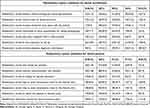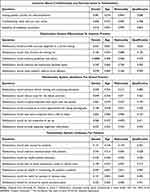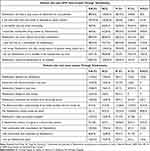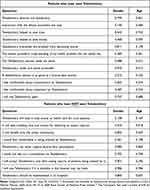Back to Journals » Clinical, Cosmetic and Investigational Dentistry » Volume 15
Teledentistry Awareness and Knowledge Among Dental Practitioners and Patients in Jeddah, Saudi Arabia
Authors Alshammari A , Almaktoom I
Received 22 June 2023
Accepted for publication 3 October 2023
Published 29 November 2023 Volume 2023:15 Pages 321—331
DOI https://doi.org/10.2147/CCIDE.S427142
Checked for plagiarism Yes
Review by Single anonymous peer review
Peer reviewer comments 3
Editor who approved publication: Professor Christopher E. Okunseri
Abdulwahhab Alshammari,1,2 Ibrahem Almaktoom1,2
1Health Informatics Department, King Saud bin Abdulaziz University for Health Sciences (KSAU-HS), Riyadh, Saudi Arabia; 2King Abdullah International Medical Research Center (KAIMRC), Ministry of the National Guard-Health Affairs(MNGHA), Riyadh, Saudi Arabia
Correspondence: Abdulwahhab Alshammari, King Saud bin Abdulaziz University for Health Science, Mail Code: 2350, P.O. Box: 3660, Riyadh, 11481, Saudi Arabia, Tel +966-11-429-5480, Email [email protected]
Purpose: Studies show that Teledentistry helps enhance communication between dental peers and patients and improves time management and education. The knowledge and awareness of Teledentistry levels need to be measured for a wider adaption. This study aimed to explore the knowledge and awareness of Teledentistry among dental practitioners and patients who live in Jeddah City, Saudi Arabia.
Patients and Methods: This study is a descriptive cross-sectional study with two participant groups. It uses five-point Likert-type quantitative, valid, and reliable questionnaires, one for dental providers and one for patients. The providers’ questionnaire covers four domains: (1) Teledentistry system effectiveness to improve practice, (2) Teledentistry system usefulness for the dental practice, (3) Teledentistry system usefulness for patients, and (4) Concerns about confidentiality and security of Teledentistry. The patients’ questionnaire covers two domains: (1) Patients who have previous experience in Teledentistry and (2) Patients who did not have previous experience in Teledentistry. The Institutional Review Board (IRB) approved this study and distributed it at teaching, governmental hospitals, and private dental clinics. Convenience and snowball sampling were used to collect responses. All consent forms have been collected from the participants.
Results: A total of 512 responses were collected using Google Forms, 203 from the dental healthcare provider and 309 from the patients. The collected data were coded and analyzed using Microsoft Excel and SPSS. More than 60% of dentists believe in the worth of Teledentistry, which helps patient education, monitors patients’ conditions, and improves the services provided to patients in remote areas. Also, more than 70% of patients believe that Teledentistry can significantly save time and money, and more than half wish that Teledentistry be applied to all hospitals.
Conclusion: Dentists and patients generally showed optimism and support for the Teledentistry concept, in addition to how Teledentistry can be beneficial for both dentists and patients.
Keywords: Teledentistry, Telehealth, dental care, cross-sectional, awareness, knowledge
Introduction
Telemedicine is an overview term for a medical activity that includes distance elements, information, and communication technologies.1 Teledentistry, like Telemedicine, is the distant or remote delivery of dental care services, consultation, education, or treatment using technologies instead of face-to-face physical interaction with patients.
Teledentistry is the practice of dentistry from a distance; it is beneficial when used in rural areas, especially for consultation by store-and-forward or real-time methods, for example, exchanging clinical information, static images, and videoconference, respectively.2 Teledentistry involves many branches of Teleorthodontic, Telepathology, Tele oral surgery, Telestomatology, Teleorofacial Pain (OFP), and Teleradiology.3
Despite the wide range of Telemedicine services, dentists are aware of Teledentistry but not its potential benefits, uses, and usability in daily practice.3 Teledentistry has the potential to promote public knowledge and improve routine dental practice with the help of technology, such as dental consultation education.
This paper will emphasize the importance of technology and Telemedicine in general and Teledentistry in specific. Teledentistry has various uses, such as reaching hard-to-reach populations and making consultants more accessible.4
In Saudi Arabia, there is a shortage of dental specialists.5,6 According to the Ministry of Health, the total number of dentists in the governmental and private sectors is 19,622, divided into 1526 consultants, 3373 registrars, and 14,723 Residents.7 These numbers lead the discussion on the importance of Teledentistry in diagnosing and treating complex cases of patients living in rural areas.5,6
This paper intends to answer the question, “What are the awareness levels and beliefs on Teledentistry among providers and patients in Jeddah, Saudi Arabia?” The main objectives of this paper are: (1) To identify areas of improvement that will encourage providers and patients to use Teledentistry applications and services. (2) To identify the Teledentistry awareness levels and beliefs of providers and patients. (3) To identify the barriers to adapting Teledentistry applications faced by providers and patients.
A cross-sectional study was published in 2015 by Boringi et al in India based on 406 questionnaires.8 The study aimed to measure the knowledge and awareness of Teledentistry levels among dental professionals (including staff and students) in a dental college. The results showed a need for Teledentistry, and there is a positive attitude toward using it; it is not practiced much among dentists.8 Another cross-sectional study by Almazrooa et al in Saudi Arabia based on 148 participants showed that dentists in Saudi Arabia supported Teledentistry in some specialties, such as oral radiology, endodontics, and oral medicine, compared to Periodontics.9
Temporomandibular Disorders (TMD) affect both the articulation and masticatory muscles. The dental subspecialty of Orofacial Pain (OFP) encompasses the diagnosis, management, and treatment plans; also, the OFP treats many Temporomandibular Joint (TMJ) disorders.10 A retrospective review was performed by Bavarian et al; 270 new patients had dental teleconsultations, and 146 returned for an in-office follow-up consultation. The in-office consultation shows that 78.8% had accurate teleconsultation diagnoses, including Temporomandibular disorders (TMD). The study shows that Teleconsultation for patients with Orofacial Pain (OFP) provides a tool for diagnosis and can help expedite treatment for patients who face challenges presenting for an in-office consultation.11
A cross-sectional study was published by Aboalshamat, K. in Saudi Arabia, based on 314 dental student participants.10 The study used a survey consisting of 41 questions that assessed the current levels of knowledge, attitudes about, practices of, and barriers to Teledentistry among dental students. The results show that dental students know little about Teledentistry. However, they are open to learning and using it.
A cross-sectional study was published in 2021 by Al-Khalifa, K. and AlSheikh, R. in Saudi Arabia, based on 286 dental professionals who participated in the study.11 The authors obtained a list of dental professionals from the Saudi Commission for Health Specialties database and randomly emailed them for participation. The results showed that most participants anticipated that Teledentistry would improve dental practice and the readiness of dental professionals to be engaged in Teledentistry.
Although similar studies in this area are available, most covered dentists’ or patients’ awareness and Knowledge of Teledentistry; this study covers the awareness of patients and dentists with different job titles. Many studies used “Yes” and “No” questionnaires, while this study uses a five-point Likert-type scale. The questionnaires used in this study are based on validated questionnaires from similar studies.8,9,12
Materials and Methods
This study used two quantitative questionnaires to cover the two main participant groups: dental healthcare providers and patients. We used one quantitative questionnaire for the patients and one quantitative questionnaire for the dental healthcare providers. The quantitative validated questionnaire used for dental healthcare providers was taken from previous studies by Estai et al and Al-Khalifa et al11,13 The dental healthcare providers’ quantitative Likert scale questionnaire contained four main parts. The first part covered professional and demographic data. The second part covered how patients’ data security concerns dental professionals. The third part covered practitioners to estimate if Teledentistry could improve the practice and how Teledentistry is helpful to practitioners. The fourth part covered the usefulness of Teledentistry for patients.
The patient questionnaire consists of two parts: patients with experience using Teledentistry and patients without previous experience with Teledentistry.9 The validated quantitative patient questionnaire was adapted from a study by Meher et al to measure patients’ knowledge and awareness of Telemedicine.14 All two questionnaires were translated into Arabic by native speakers who specialized in dentistry and double-checked by a group of native speakers who specialized in the Arabic language field. The sample size was calculated using OpenEpi V3 with a confidence interval of 95% and margins of error of 5% for dental healthcare providers and patients.15
This study was approved by the Institutional Review Board (IRB) of King Abdullah International Medical Research Center (KAIMRC) and distributed at King Abdulaziz University Dental College as an educational and governmental hospital, Vision College as an educational institution, and Biolife Clinic as a private clinic in Jeddah, Saudi Arabia.
This study’s targeted dental healthcare providers included senior undergraduate students, interns, general dentists, postgraduate students, specialists, and consultants. In this study, we used an electronic questionnaire (Google Forms) and hard copies for participants who were unwilling or unable to take the electronic questionnaire. Seven dentists and fifteen patients performed a piloting questionnaire to identify and correct any mistakes or ambiguities affecting the overall data collection process; the pilot samples were not included in the final results and analysis. Then, the surveys were distributed to the participants. The data from the returned hard copies and electronic questionnaires were coded. Convenience and snowball sampling were used to collect responses from participants.
The data were transferred from Google Forms to a code book, then to a Microsoft Excel spreadsheet (2010), and then to SPSS version 22. Descriptive statistics were used to summarize demographic data, and a Chi-square test was performed. Finally, a p-value of 0.05 was used for statistical significance, and the Chi-square test of independence was used to determine whether or not there was a significant association between two categorical variables.
Results
The questionnaires were distributed to participants electronically or as hard copies between October and November of 2021. The total number of included questionnaires is 512. For dental care providers, we included 203 questionnaires (137 hard copies and 108 soft copies). For dental patients, we included 309 questionnaires (201 hard copies and 76 soft copies). We excluded duplicated questionnaires or any questionnaire with missing data. We excluded any dentists not currently practicing dentistry (at the time of the survey) or practicing outside Jeddah.
Dental Healthcare Providers
For the demographic and professional characteristics of dental respondents, Figure 1 shows that the majority of respondents to the dental questionnaire were aged 18–29 years. More than half of the participants were senior dental students and interns (40.9% and 19.7%, respectively), followed by consultants (13.8%), general dentists (11.8%), and postgraduate students and specialists (6.9% each). The majority of participants, 51.2%, were practicing dentistry in public institutions, 43.3% were practicing in the private sector, and 5.4% were practicing in both the public and private sectors. The plurality of dental healthcare providers participating in the dental survey (177 or 87%) were Saudi dentists. More than half of the participants do not have a Saudi Dental License (SDL) because they are undergraduate dental students or interns.
 |
Figure 1 Demographic information on the participants covered (a) Age Category Groups, (b) Gender, (c) Nationality, (d) Qualification Type, (e) Place of Practicing, and (f) Saudi Dental Licensure. |
For the concerns about confidentiality and security issues in Teledentistry, Table 1 shows a high concern about the reliability of Teledental equipment (over 57%) and the confidentiality of data sent online (over 45%). In contrast, the results show less concern about gaining patient consent for Teleconsultation (about 27%).
 |
Table 1 Confidentiality, Securities, and Effectiveness Issues in Teledentistry |
Regarding the effectiveness of the teledentistry system in improving practice, Table 1 shows that more than 63% of participants were unsure that Teledentistry would give an accurate diagnosis in a clinical setting. Still, more than 55% agreed or strongly agreed that Teledentistry could improve the patient referral process and interaction between colleagues, increase the efficiency of advice and guidelines, and shorten the waiting list.
For the Teledentistry system’s usefulness for dental practice, Table 2 shows that most participants found that the Teledentistry system could help save time compared to the traditional referral method. Half of the respondents agreed that Teledentistry could reduce the cost of a dental practice, while 25% were neutral. However, there was a concurrent result in the opinion between agreement, neutrality, and disagreement regarding Teledentistry’s ability to enhance clinical training, continuing education, and time spent with patients. Half of the participants were doubtful that Teledentistry could provide adequate diagnostic information, and 58% felt that Teledentistry requires extra appointments for photography. More than 38% thought setting up a Teledentistry system would not be too expensive, 31% were neutral, and another 31% felt it would be.
 |
Table 2 Teledentistry System Usefulness for Dental Practices for Practitioners and Patients |
For the Teledentistry system’s usefulness for patients, Table 2 shows that dental healthcare providers generally believe that Teledentistry has potential benefits for patients; more than 70% have faith that Teledentistry helps in patient education, monitoring of the patient’s condition and improving services to patients in remote areas. In addition, more than 60% believe that the service should be covered by insurance and help avoid unnecessary travel to the dental clinic; more than 50% agree or strongly agree that Teledentistry can save patients money and improve communication with them.
The Chi-Square Test of Independence was used to determine whether or not there is a significant association between two categorical variables; a p-value of 0.05 was used for statistical significance. Among dental healthcare providers, the Chi-square tests show a correlation between the belief that Teledentistry can provide an accurate diagnosis in a clinical setting and gender, age, nationality, and qualification. They also offer the statistical importance of time saved by Teledentistry for referral letters with age, gender, and confidentiality when data are sent online, see Table 3.
 |
Table 3 The Chi-Square Test Results for Dentalcare Providers |
Dental Patients
For the demographic characteristics of patient respondents, Figure 2 shows that most respondents to the patient questionnaire were 18–29 years old, and responses decreased with age; most participants were female (72.8%). Of the 309 respondents, 270 (87.3%) were unaware of Teledentistry.
For the patients who have never been treated through Teledentistry, Table 4 shows that more than 77% of the respondents believe that Teledentistry could save travel time and money and help rural patients with healthcare access. More than 60% believe that Teledentistry should be implemented in all hospitals, though it will not replace face-to-face consultation. 42% say that they cannot rely on Teledentistry consultation; almost half of the participants would use Teledentistry if it were available in the hospital near their town. The results for patients who would feel comfortable being treated by Teledentistry were almost evenly distributed.
 |
Table 4 Patients Who Have and Have Not Been Treated Through Teledentistry |
For the patients who have been treated through Teledentistry, Table 4 shows that most Teledentistry users were 30–34 years old, while no one above 49 years old had previous experience using Teledentistry. Table 4 shows that 72–82% of participants were satisfied with Teledentistry sessions, were pleased with the interaction with distant dental providers, and affirmed the role of Teledentistry in saving money and time.
Between 60% and 69% of patients agreed that Teledentistry prevented their problem from worsening and made healthcare easily accessible; they feel comfortable about consultation and treatment by Teledentistry and will use it again. For face-to-face sessions, only 20.5%; 46% were neutral, and 51% objected that Teledentistry sessions made them tense. 48% did not face issues about being understood by distant providers when they described their health problems.
Among patients with no previous experience with Teledentistry, the Chi-square tests show age significantly correlated with travel time and money savings. Also, age is correlated significantly with the belief that Teledentistry makes dental care easily accessible, see Table 5.
 |
Table 5 The Chi-Square Test Results for Patients |
Discussion
To our knowledge, this is the first study to measure the awareness and Knowledge of Teledentistry of dentists and patients in the same study in Saudi Arabia. It is also the first to focus on Jeddah City. The questionnaires were distributed to three organizations to cover different healthcare organizations (educational and governmental hospitals and private clinics). The dental questionnaire encompasses all kinds of work levels in the dental field to have a larger sample population and perspectives.
Dental and patient participants who used Teledentistry were optimistic about the use of Teledentistry, believing that it could lower expenses, save time, and improve service quality and outcomes. Also, it seems patients with no previous experience in Teledentistry were willing to try it and thought it would positively impact them. On the other hand, dental practitioners feel that Teledentistry is not mature enough to provide accurate diagnostic services, and patients are not entirely comfortable being treated or relying on consultation through Teledentistry.
Teledentistry is not widely used in Jeddah; of 270 respondents, almost 87.3% were not aware of its existence. This finding leads us to the need to increase the awareness and knowledge of the usefulness of Teledentistry and to enhance the technology’s efficiency and ease of use; this is apart from the fact that no one more than 45 years old had used Teledentistry before; a total of 39 had had previous experience in Teledentistry.
A limitation of this study was time constraints that only allowed us to have fewer participants with higher qualifications. Another limitation was that many participants chose neutral as an answer on the 5-point Likert scale, which gives no definite response. In the future, we would like to have more equal numbers of participant groups to have a more generalizable opinion on each group. Also, this will allow for discussion on the spatiality of data security and reliability. Data security must be improved, and dentists and patients must be better educated about the efficiency of Teledentistry services to increase the level of acceptance and usage of Teledentistry services. Having the newest Teledentistry technology would be good, but it should be supported by the proper infrastructure design. A solution like standardized software and hardware compatibility is necessary to increase the interoperability between different technologies, which will eventually help reduce errors, cost, and implementation and processing time.13,16
Finally, teaching the practical benefits of Teledentistry would motivate more dentists and patients to use it, and the authorities should make clear, well-defined regulations and laws to establish its safe use. Furthermore, it will be necessary to re-evaluate the opinions of healthcare providers and consumers to detect if any additional issues have appeared or been discovered once Teledentistry is widely used.
Conclusion
Dental practitioners in Jeddah know the importance of Teledentistry in shortening the waiting list, enhancing the accessibility of information from specialists, increasing consultation between peers, helping the referral system, and saving time for both patient and practitioner. Also, they understand that it will decrease expenses, improve communication with patients, raise the education level, help monitor patients in rural areas, and avoid unnecessary travel expenses and time. Patients who used Teledentistry showed a high awareness and knowledge of its use and were satisfied with it. Patients with no previous experience with Teledentistry showed good responses and awareness of the potential benefits of Teledentistry, and they need to see the results of prior users’ experiences to be more motivated and secure. This study provides us with many findings on the importance of increasing the Knowledge and awareness of Teledentistry. Dentists and patients seem willing to use Teledentistry, some only after improvements and sufficiently motivating results.
Acknowledgments
We want to acknowledge all the participants in this study. We wish to extend our acknowledgments to the following for their contribution to the distributing surveys, collecting surveys, and technical assistance: Ms. Raneem Radi, Ms. Ghadeer Almagrabi, Dr. Khaled Albarqi, Dr. Arwa Alsaggaf, Dr. Ahmed Halawani, and Dr. Mohamed Alsahar, and Dr. Fahad Almalki.
Disclosure
The authors report no conflicts of interest in this work.
References
1. Institute of Medicine (U.S.). Committee on Evaluating Clinical Applications of Telemedicine. In: Field MJ, editor. Telemedicine: A Guide to Assessing Telecommunications in Health Care. National Academies Press (U.S.); 1996. Available from: http://www.ncbi.nlm.nih.gov/books/NBK45448/.
2. Sultana SS, Chole RH, Adalja C, Patel P, Peter R. Knowledge, awareness and attitude among dentist and dental students about Teledentistry. J Adv Health Sci Res. 2020;1(1):17–24.
3. Estai M, Kruger E, Tennant M. Perceptions of Australian dental practitioners about using telemedicine in dental practice. Br Dent J. 2016;220(1):25–29. doi:10.1038/sj.bdj.2016.25
4. Pradhan D, Verma P, Sharma L, Khaitan T. Knowledge, awareness, and attitude regarding Teledentistry among postgraduate dental students of Kanpur city, India: a questionnaire study. J Educ Health Promot. 2019;8(1):104. doi:10.4103/JEHP.JEHP_363_18
5. Saudi Ministry of Health. Statistical Yearbook - Health Indicators. Saudi Ministry of Health; 2022. Available from: https://www.moh.gov.sa/en/Ministry/Statistics/book/Pages/default.aspx.
6. Ministry of Health. Statistical Yearbook 2020-Chapter II: Resources. Ministry of Health; 2020.
7. Global Health Data Exchange. Saudi Arabia Health Statistical Yearbook 2010. GHDx. Available from: https://ghdx.healthdata.org/record/saudi-arabia-health-statistical-yearbook-2010.
8. Boringi M, Waghray S, Lavanya R, et al. Knowledge and awareness of Teledentistry among dental professionals – a cross sectional study. J Clin Diagnos Res. 2015;9(8):ZC41–ZC44. doi:10.7860/JCDR/2015/13303.6320
9. Almazrooa SA, Mansour GA, Alhamed SA, et al. The application of Teledentistry for Saudi patients’ care: a national survey study. J Dent Sci. 2021;16(1):280–286. doi:10.1016/j.jds.2020.04.014
10. Schiffman E, Ohrbach R. Executive summary of the diagnostic criteria for temporomandibular disorders for clinical and research applications. J Am Dent Assoc. 2016;147(6):438–445. doi:10.1016/j.adaj.2016.01.007
11. Bavarian R, Pharr CA, Handa S, Shaefer J, Keith DA. The utility of Telemedicine in orofacial pain: guidelines for examination and a retrospective review at a hospital-based practice. J Oral Rehabil. 2022;49(8):778–787. doi:10.1111/joor.13335
12. Aboalshamat KT. Awareness of, beliefs about, practices of, and barriers to Teledentistry among dental students and the implications for Saudi Arabia vision 2030 and coronavirus pandemic. J Int Soc Prev Community Dent. 2020;10(4):431–437. doi:10.4103/jispcd.JISPCD_183_20
13. Al-Khalifa KS, AlSheikh R, Denis F. Teledentistry awareness among dental professionals in Saudi Arabia. PLoS One. 2020;15(10):e0240825. doi:10.1371/journal.pone.0240825
14. Queyroux A, Saricassapian B, Herzog D, et al. Accuracy of Teledentistry for diagnosing dental pathology using direct examination as a gold standard: results of the Tel-e-dent study of older adults living in nursing homes. J Am Med Dir Assoc. 2017;18(6):528–532. doi:10.1016/J.JAMDA.2016.12.082
15. Estai M, Bunt S, Kanagasingam Y, Kruger E, Tennant M. Diagnostic accuracy of Teledentistry in the detection of dental caries: a systematic review. J Evid Based Dent Pract. 2016;16(3):161–172. doi:10.1016/J.JEBDP.2016.08.003
16. Meher SK, Tyagi RS, Chaudhry T. Awareness and attitudes to Telemedicine among doctors and patients in India. J Telemed Telecare. 2009;15(3):139–141. doi:10.1258/jtt.2009.003011
17. Woldaregay AZ, Walderhaug S, Hartvigsen G. Telemedicine services for the Arctic: a systematic review. JMIR Med Inform. 2017;5(2):e6323. doi:10.2196/medinform.6323
 © 2023 The Author(s). This work is published and licensed by Dove Medical Press Limited. The full terms of this license are available at https://www.dovepress.com/terms.php and incorporate the Creative Commons Attribution - Non Commercial (unported, v3.0) License.
By accessing the work you hereby accept the Terms. Non-commercial uses of the work are permitted without any further permission from Dove Medical Press Limited, provided the work is properly attributed. For permission for commercial use of this work, please see paragraphs 4.2 and 5 of our Terms.
© 2023 The Author(s). This work is published and licensed by Dove Medical Press Limited. The full terms of this license are available at https://www.dovepress.com/terms.php and incorporate the Creative Commons Attribution - Non Commercial (unported, v3.0) License.
By accessing the work you hereby accept the Terms. Non-commercial uses of the work are permitted without any further permission from Dove Medical Press Limited, provided the work is properly attributed. For permission for commercial use of this work, please see paragraphs 4.2 and 5 of our Terms.

